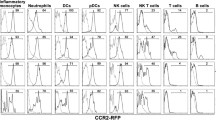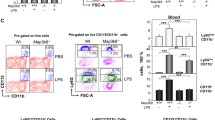Abstract
The chemokine receptor CXCR4 and its unique ligand, stromal-derived factor 1 (SDF-1), play critical roles in the retention of hematopoietic cells within bone marrow and in their mobilization into the circulation. Surface CXCR4 down-regulation in hematopoietic cells is associated with a loss of retention of the cells in bone marrow. Lipopolysaccharide (LPS), commonly referred to as endotoxin, induces neutrophilia in vivo, but the mechanism of mobilization related to neutrophilia has not been fully clarified. We show that LPS reduces CXCR4 surface expression in a dose- and time-dependent manner in neutrophils and monocytes, but not in lymphocytes. Polymyxin B neutralization of LPS in culture supernatants still induced this down-modulation, and LPS-stimulated neutrophils released interferon γ and interleukin 1β. These results provide evidence that CXCR4 down-regulation can be attributed to soluble factors released by neutrophils upon LPS treatment. Moreover, LPS treatment increased CXCR4 messenger RNA in neutrophils, suggesting that the down-regulation of surface CXCR4 is caused by a posttranslational mechanism, and the chemotactic migration of neutrophils in response to SDF-1 was reduced by LPS pretreatment.Thus, the present study has shown that by down-regulating neutrophil CXCR4 expression and attenuating neutrophil responsiveness to SDF-1, LPS can mobilize neutrophils from bone marrow to the peripheral blood through reducing neutrophil retention in bone marrow.
Similar content being viewed by others
References
Dobrovolskaia MA, Vogel SN. Toll receptors, CD14, and macrophage activation and deactivation by LPS. Microbes Infect. 2002;4:903–914.
Zarember KA, Godowski PJ. Tissue expression of human Toll-like receptors and differential regulation of Toll-like receptor mRNAs in leukocytes in response to microbes, their products, and cytokines. J Immunol. 2002;168:554–561.
Wagner JG, Roth RA. Neutrophil migration during endotoxemia. J Leukoc Biol. 1999;66:10–24.
Wolff SM, Rubenstein M, Mulholland JH, Alling DW. Comparison of hematologic and febrile response to endotoxin in man. Blood. 1965;26:190–201.
Granowitz EV, Porat R, Mier JW, et al. Hematologic and immuno-modulatory effects of an interleukin-1 receptor antagonist coinfu- sion during low-dose endotoxemia in healthy humans. Blood. 1993;82:2985–2990.
Link DC. Neutrophil homeostasis: a new role for stromal cell-derived factor-1. Immunol Res. 2005;32:169–178.
Burger JA, Kipps TJ. CXCR4: a key receptor in the crosstalk between tumor cells and their microenvironment. Blood. 2006;107:1761–1767.
Ma Q, Jones D, Springer TA. The chemokine receptor CXCR4 is required for the retention of B lineage and granulocytic precursors within the bone marrow microenvironment. Immunity. 1999;10:463–471.
Kim HK, De La Luz Sierra M, Williams CK, Gulino AV, Tosato G. G-CSF down-regulation of CXCR4 expression identified as a mechanism for mobilization of myeloid cells. Blood. 2006;108:812–820.
Martin C, Burdon PC, Bridger G, Gutierrez-Ramos JC, Williams TJ, Rankin SM. Chemokines acting via CXCR2 and CXCR4 control the release of neutrophils from the bone marrow and their return following senescence. Immunity. 2003;19:583–593.
Aiuti A, Webb IJ, Bleul C, Springer T, Gutierrez-Ramos JC. The chemokine SDF-1 is a chemoattractant for human CD34+ hemato- poietic progenitor cells and provides a new mechanism to explain the mobilization of CD34+ progenitors to peripheral blood. J Exp Med. 1997;185:111–120.
Valenzuela-Fernandez A, Planchenault T, Baleux F, et al. Leukocyte elastase negatively regulates stromal cell-derived factor-1 (SDF-1)/CXCR4 binding and functions by amino-terminal processing of SDF-1 and CXCR4. J Biol Chem. 2002;277:15677–15689.
Levesque JP, Hendy J, Takamatsu Y, Simmons PJ, Bendall LJ. Disruption of the CXCR4/CXCL12 chemotactic interaction during hematopoietic stem cell mobilization induced by GCSF or cyclophosphamide. J Clin Invest. 2003;111:187–196.
Forster R, Kremmer E, Schubel A, et al. Intracellular and surface expression of the HIV-1 coreceptor CXCR4/fusin on various leukocyte subsets: rapid internalization and recycling upon activation. J Immunol. 1998;160:1522–1531.
Brelot A, Heveker N, Montes M, Alizon M. Identification of residues of CXCR4 critical for human immunodeficiency virus coreceptor and chemokine receptor activities. J Biol Chem. 2000;275:23736–23744.
Nagase H, Miyamasu M, Yamaguchi M, et al. Cytokine-mediated regulation of CXCR4 expression in human neutrophils. J Leukoc Biol. 2002;71:711–717.
Wang J, Guan E, Roderiquez G, Calvert V, Alvarez R, Norcross MA. Role of tyrosine phosphorylation in ligand-independent sequestration of CXCR4 in human primary monocytes-macrophages. J Biol Chem. 2001;276:49236–49243.
Gallay P, Jongeneel CV, Barras C, et al. Short time exposure to lipopolysaccharide is sufficient to activate human monocytes. J Immunol. 1993;150:5086–5093.
Suratt BT, Petty JM, Young SK, et al. Role of the CXCR4/SDF-1 chemokine axis in circulating neutrophil homeostasis. Blood. 2004;104:565–571.
Fuchs E, Tumbar T, Guasch G. Socializing with the neighbors: stem cells and their niche. Cell. 2004;116:769–778.
Ponomaryov T, Peled A, Petit I, et al. Induction of the chemokine stromal-derived factor-1 following DNA damage improves human stem cell function. J Clin Invest. 2000;106:1331–1339.
Broxmeyer HE, Orschell CM, Clapp DW, et al. Rapid mobilization of murine and human hematopoietic stem and progenitor cells with AMD3100, a CXCR4 antagonist. J Exp Med. 2005;201:1307–1318.
Mechanic RC, Frei E 3rd, Landy M, Smith WW. Quantitative studies of human leukocytic and febrile response to single and repeated doses of purified bacterial endotoxin. J Clin Invest. 1962;41:162–172.
Velders GA, van Os R, Hagoort H, et al. Reduced stem cell mobilization in mice receiving antibiotic modulation of the intestinal flora: involvement of endotoxins as cofactors in mobilization. Blood. 2004;103:340–346.
Verani A, Sironi F, Siccardi AG, Lusso P, Vercelli D. Inhibition of CXCR4-tropic HIV-1 infection by lipopolysaccharide: evidence of different mechanisms in macrophages and T lymphocytes. J Immunol. 2002;168:6388–6395.
Kucia M, Jankowski K, Reca R, et al. CXCR4-SDF-1 signalling, locomotion, chemotaxis and adhesion. J Mol Histol. 2004;35:233–245.
Moser B, Wolf M, Walz A, Loetscher P. Chemokines: multiple levels of leukocyte migration control. Trends Immunol. 2004;25:75–84.
Bruhl H, Cohen CD, Linder S, Kretzler M, Schlondorff D, Mack M. Post-translational and cell type-specific regulation of CXCR4 expression by cytokines. Eur J Immunol. 2003;33:3028–3037.
Xu L, Khandaker MH, Barlic J, et al. Identification of a novel mechanism for endotoxin-mediated down-modulation of CC chemokine receptor expression. Eur J Immunol. 2000;30:227–235.
Fernandis AZ, Cherla RP, Chernock RD, Ganju RK. CXCR4/ CCR5 down-modulation and chemotaxis are regulated by the pro- teasome pathway. J Biol Chem. 2002;277:18111–18117.
Cassatella MA. Neutrophil-derived proteins: selling cytokines by the pound. Adv Immunol. 1999;73:369–509.
Yeaman GR, Collins JE, Currie JK, Guyre PM, Wira CR, Fanger MW. IFN-γ is produced by polymorphonuclear neutrophils in human uterine endometrium and by cultured peripheral blood polymorphonuclear neutrophils. J Immunol. 1998;160:5145–5153.
Khandaker MH, Xu L, Rahimpour R, et al. CXCR1 and CXCR2 are rapidly down-modulated by bacterial endotoxin through a unique agonist-independent, tyrosine kinase-dependent mechanism. J Immunol. 1998;161:1930–1938.
Author information
Authors and Affiliations
Corresponding author
About this article
Cite this article
Kim, H.K., Kim, JE., Chung, J. et al. Surface Expression of Neutrophil CXCR4 is Down-Modulated by Bacterial Endotoxin. Int J Hematol 85, 390–396 (2007). https://doi.org/10.1532/IJH97.A30613
Received:
Revised:
Accepted:
Published:
Issue Date:
DOI: https://doi.org/10.1532/IJH97.A30613




